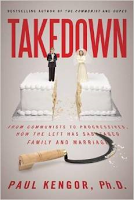Richard Nixon stood by a lemon-yellow refrigerator in Moscow and bragged to the Soviet leader: “The American system,” he told Nikita Khrushchev over frosted cupcakes and chocolate layer cake, “is designed to take advantage of new inventions.”
It was the opening day of the American National Exhibition at Sokol’niki Park, and Nixon was representing not just the US government but also the latest products from General Mills, Whirlpool, and General Electric. Assisting him in what would come to be known as the “Kitchen Debates” were attractive American spokesmodels who demonstrated for the Russian crowd the best that capitalism in 1959 had to offer.
Capitalist lifestyle
“This was the first time,” writes British food historian Bee Wilson of the summer exhibition, that “many Russians had encountered the American lifestyle firsthand: the first time they … set eyes on big American refrigerators.”
Laughing and sometimes jabbing fingers at one another, the two men debated the merits of capitalism and communism. Which country had the more advanced technologies? Which way of life was better? The conversation … hinged not on weapons or the space race but on washing machines and kitchen gadgets. (Consider the Fork)
Khrushchev was dismissive. Yes, the Americans had brought some fancy machines with them, but did all this consumer technology actually offer any real advantages?
In his memoirs, he later recalled picking up an automatic lemon squeezer. “What a silly thing … Mr. Nixon! … I think it would take a housewife longer to use this gadget than it would for her to … slice a piece of lemon, drop it into a glass of tea, then squeeze a few drops.”
Producing necessities
That same year, Khrushchev announced that the Soviet economy would overtake the United States in the production of milk, meat, and butter. These were products that made sense to him. He couldn’t deliver — although Soviet farmers were forced to slaughter their breeding herds in an attempt to do so — but the goal itself reveals what the communist leader believed a healthy economy was supposed to do: produce staples like meat and dairy, not luxuries like colorful kitchenware and complex gadgetry for the decadent and lazy.
“Don’t you have a machine,” he asked Nixon, “that puts food in the mouth and presses it down? Many things you’ve shown us are interesting but they are not needed in life. They have no useful purpose. They are merely gadgets.”
Khrushchev was displaying the behavior Ludwig von Mises described in The Anti-Capitalistic Mentality. “They castigate the luxury, the stupidity and the moral corruption of the exploiting classes,” Mises wrote of the socialists. “In their eyes everything that is bad and ridiculous is bourgeois, and everything that is good and sublime is proletarian.”
On display that summer in Moscow was American consumer tech at its most bourgeois. The problem with “castigating the luxury,” as Mises pointed out, is that all “innovation is first a luxury of only a few people, until by degrees it comes into the reach of the many.”
Producing luxuries
It is appropriate that the Kitchen Debate over luxury versus necessity took place among high-end American refrigerators. Refrigeration, as a luxury, is ancient. “There were ice harvests in China before the first millennium BC,” writes Wilson. “Snow was sold in Athens beginning in the fifth century BC. Aristocrats of the seventeenth century spooned desserts from ice bowls, drank wine chilled with snow, and even ate iced creams and water ices. Yet it was only in the nineteenth century in the United States that ice became an industrial commodity.” Only with modern capitalism, in other words, does the luxury reach so rapidly beyond a tiny elite.
“Capitalism,” Mises wrote in Economic Freedom and Interventionism, “is essentially mass production for the satisfaction of the wants of the masses.”
The man responsible for bringing ice to the overheated multitude was a Boston businessman named Frederic Tudor. “History now knows him as ‘the Ice King,’” Steven Johnson writes of Tudor in How We Got to Now: Six Innovations That Made the Modern World, “but for most of his early adulthood he was an abject failure, albeit one with remarkable tenacity.”
Like many wealthy families in northern climes, the Tudors stored blocks of frozen lake water in icehouses, two-hundred-pound ice cubes that would remain marvelously unmelted until the hot summer months arrived, and a new ritual began: chipping off slices from the blocks to freshen drinks [and] make ice cream.
In 1800, when Frederic was 17, he accompanied his ill older brother to Cuba. They were hoping the tropical climate would improve his brother’s health, but it “had the opposite effect: arriving in Havana, the Tudor brothers were quickly overwhelmed by the muggy weather.” They reversed course, but the summer heat chased them back to the American South, and Frederic longed for the cooler climes of New England. That experience “suggested a radical — some would say preposterous — idea to young Frederic Tudor: if he could somehow transport ice from the frozen north to the West Indies, there would be an immense market for it.”
“In a country where at some seasons of the year the heat is almost unsupportable,” Tudor wrote in his journal, “ice must be considered as outdoing most other luxuries.”
Tudor’s folly
Imagine what an early 19th-century version of Khrushchev would have said to the future Ice King. People throughout the world go hungry, and you, Mr. Tudor, want to introduce frozen desserts to the tropics? What of beef? What of butter? The capitalists chase profits rather than producing the necessities.
It’s true that Tudor was pursuing profits, but his idea of ice outdoing “most other luxuries” looked to his contemporaries more like chasing folly than fortune.
The Boston Gazette reported on one of his first shiploads of New England ice: “No joke. A vessel with a cargo of 80 tons of Ice has cleared out from this port for Martinique. We hope this will not prove to be a slippery speculation.”
And at first the skeptics seemed right. Tudor “did manage to make some ice cream,” Johnson tells us. And that impressed a few of the locals. “But the trip was ultimately a complete failure.” The novelty of imported ice was just too novel. Why supply ice where there was simply no demand?
You can’t put a price on failure
In the early 20th century, economists Ludwig von Mises and F.A. Hayek, after years of debate with the Marxists, finally began to convince advocates of socialist central planning that market prices were essential to the rational allocation of scarce resources. Some socialist theorists responded with the idea of using capitalist market prices as a starting point for the central planners, who could then simulate the process of bidding for goods, thereby replacing real markets with an imitation that they believed would be just as good. Capitalism would then be obsolete, an unfortunate stage in the development of greater social justice.
By 1959, Khrushchev could claim, however questionably, that Soviet refrigerators were just as good as the American variety — except for a few frivolous features. But there wouldn’t have been any Soviet fridges at all if America hadn’t led the way in artificial refrigeration, starting with Tudor’s folly a century and a half earlier. If the central planners had been around in 1806 when the Boston Gazette poked fun at Tudor’s slippery speculation, what prices would they have used as the starting point for future innovation? All the smart money was in other ventures, and Tudor was on his way to losing his family’s fortune and landing in debtor’s prison.
Only through stubborn persistence did Tudor refine his idea and continue to innovate while demand slowly grew for what he had to offer.
“Still pursued by his creditors,” Johnson writes, Tudor
began making regular shipments to a state-of-the-art icehouse he had built in Havana, where an appetite for ice cream had been slowly maturing. Fifteen years after his original hunch, Tudor’s ice trade had finally turned a profit. By the 1820s, he had icehouses packed with frozen New England water all over the American South. By the 1830s, his ships were sailing to Rio and Bombay. (India would ultimately prove to be his most lucrative market.)
The world the Ice King made
In the winter of 1846–47, Henry David Thoreau watched a crew of Tudor’s ice cutters at work on Walden Pond.
Thoreau wrote, “The sweltering inhabitants of Charleston and New Orleans, of Madras and Bombay and Calcutta, drink at my well.… The pure Walden water is mingled with the sacred water of the Ganges.”
When Tudor died in 1864, Johnson tells us, he “had amassed a fortune worth more than $200 million in today’s dollars.”
The Ice King had also changed the fortunes of all Americans, and reshaped the country in the process. Khrushchev would later care about butter and beef, but before refrigerated train cars — originally cooled by natural ice — it didn’t matter how much meat and dairy an area could produce if it could only be consumed locally without spoiling. And only with the advent of the home icebox could families keep such products fresh. Artificial refrigeration created the modern city by allowing distant farms to feed the growing urban populations.
A hundred years after the Boston Gazette reported what turned out to be Tudor’s failed speculation, the New York Times would run a very different headline: “Ice Up to 40 Cents and a Famine in Sight”:
Not in sixteen years has New York faced such an iceless prospect as this year. In 1890 there was a great deal of trouble and the whole country had to be scoured for ice. Since then, however, the needs for ice have grown vastly, and a famine is a much more serious matter now than it was then.
“In less than a century,” Johnson observes, “ice had gone from a curiosity to a luxury to a necessity.”
The world that luxury made
Before modern markets, Mises tells us, the delay between luxury and necessity could take centuries, but “from its beginnings, capitalism displayed the tendency to shorten this time lag and finally to eliminate it almost entirely. This is not a merely accidental feature of capitalistic production; it is inherent in its very nature.” That’s why everyone today carries a smartphone — and in a couple of years, almost every wrist will bear a smartwatch.
The Cold War is over, and Khrushchev is no longer around to scoff, but the Kitchen Debate continues as the most visible commercial innovations produce “mere gadgets.” Less visible is the steady progress in the necessities, including the innovations we didn’t know were necessary because we weren’t imagining the future they would bring about. Even less evident are all the failures. We talk of profits, but losses drive innovation forward, too.
It’s easy to admire the advances that so clearly improve lives: ever lower infant mortality, ever greater nutrition, fewer dying from deadly diseases. It’s harder to see that the larger system of innovation is built on the quest for comfort, for entertainment, for what often looks like decadence. But the long view reveals that an innovator’s immediate goals don’t matter as much as the system that promotes innovation in the first place.
Even if we give Khrushchev the benefit of the doubt and assume that he really did care about feeding the masses and satisfying the most basic human needs, it’s clear the Soviet premier had no idea how economic development works. Progress is not driven by producing ever more butter; it is driven by ice cream.

B.K. Marcus
B.K. Marcus is managing editor of the Freeman.












 I am always fascinated by how politicians, once elected, don’t do what they promised in order to get elected. Rather they become part of “the system”. They become influenced by bureaucrats, forget they represent their constituents and pass laws, rules, and regulations which harm their very constituents. They in effect become group thinkers.
I am always fascinated by how politicians, once elected, don’t do what they promised in order to get elected. Rather they become part of “the system”. They become influenced by bureaucrats, forget they represent their constituents and pass laws, rules, and regulations which harm their very constituents. They in effect become group thinkers.










